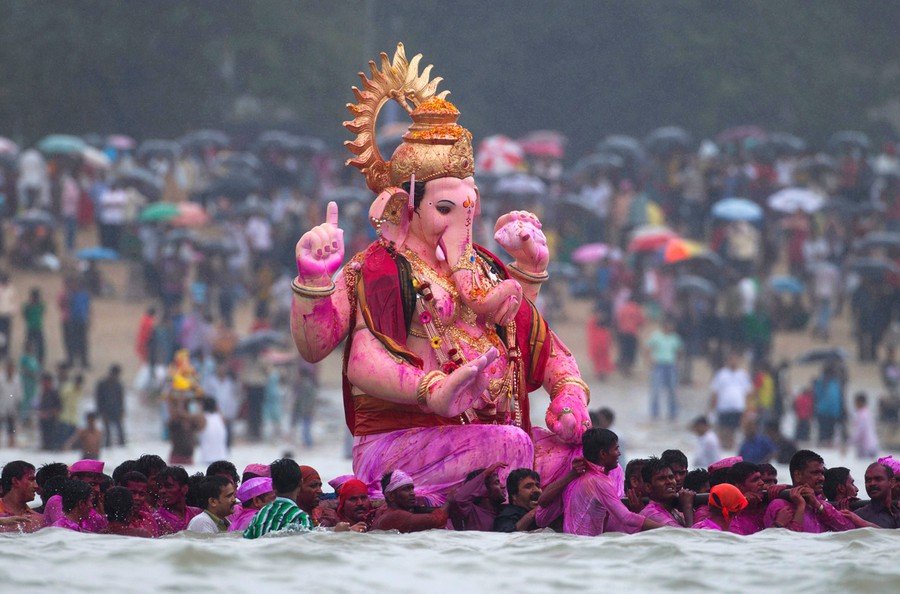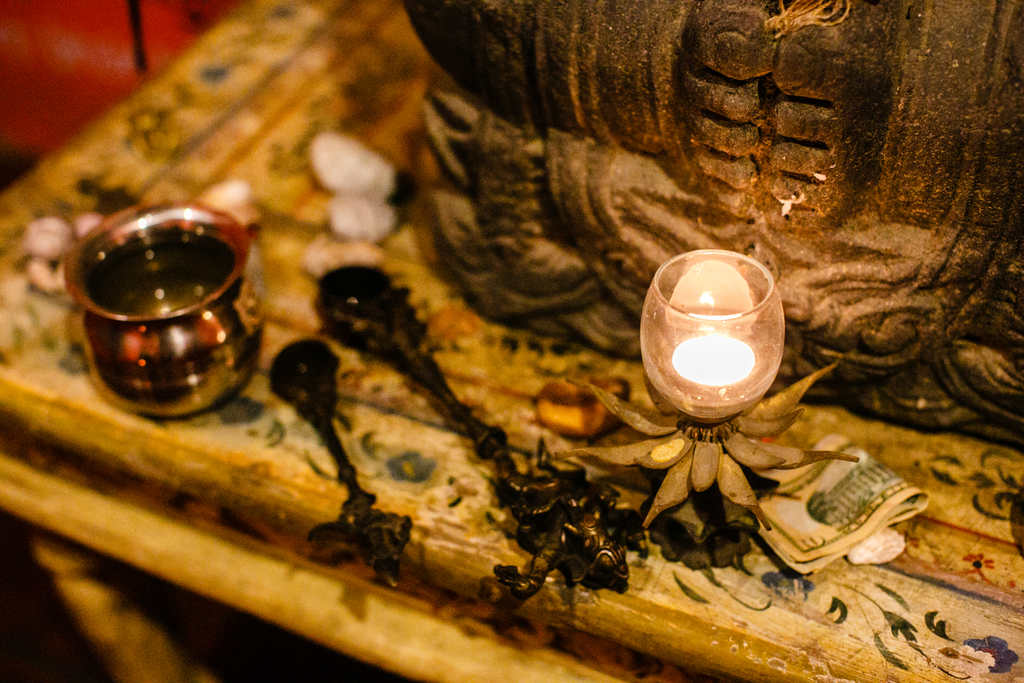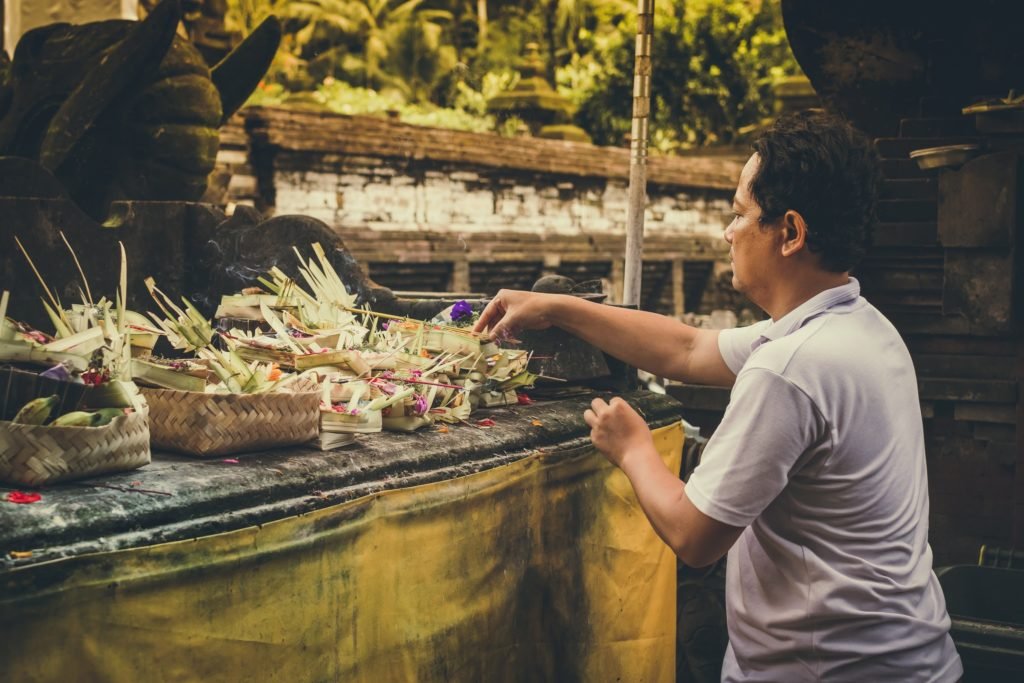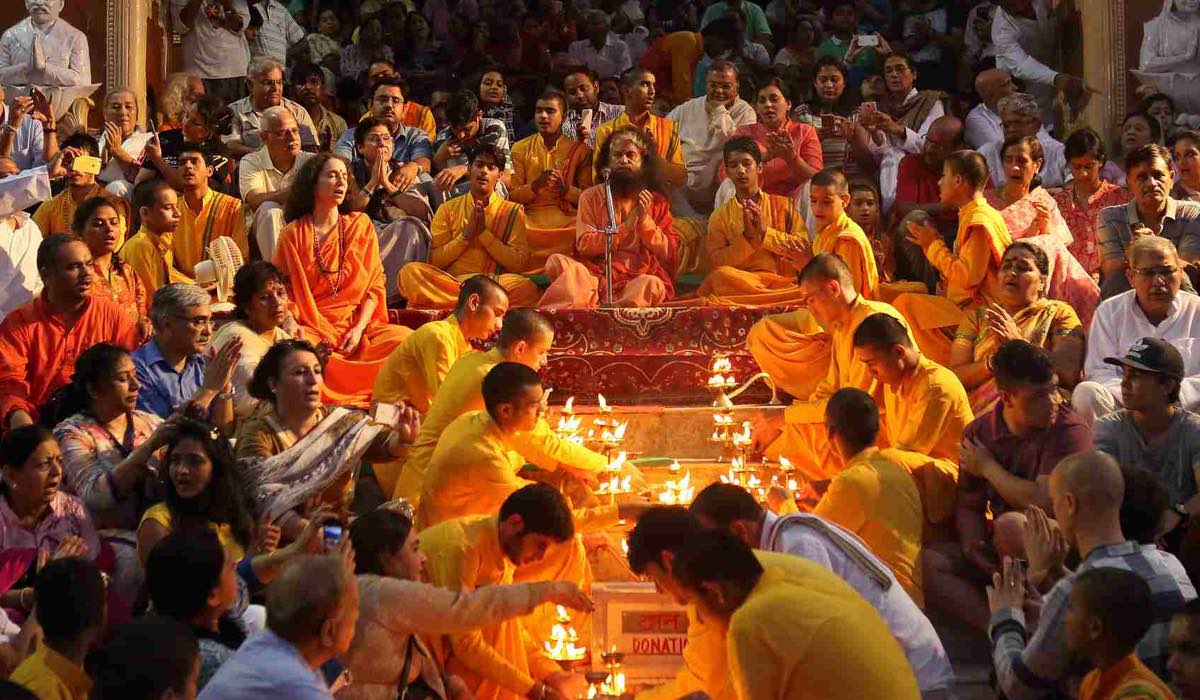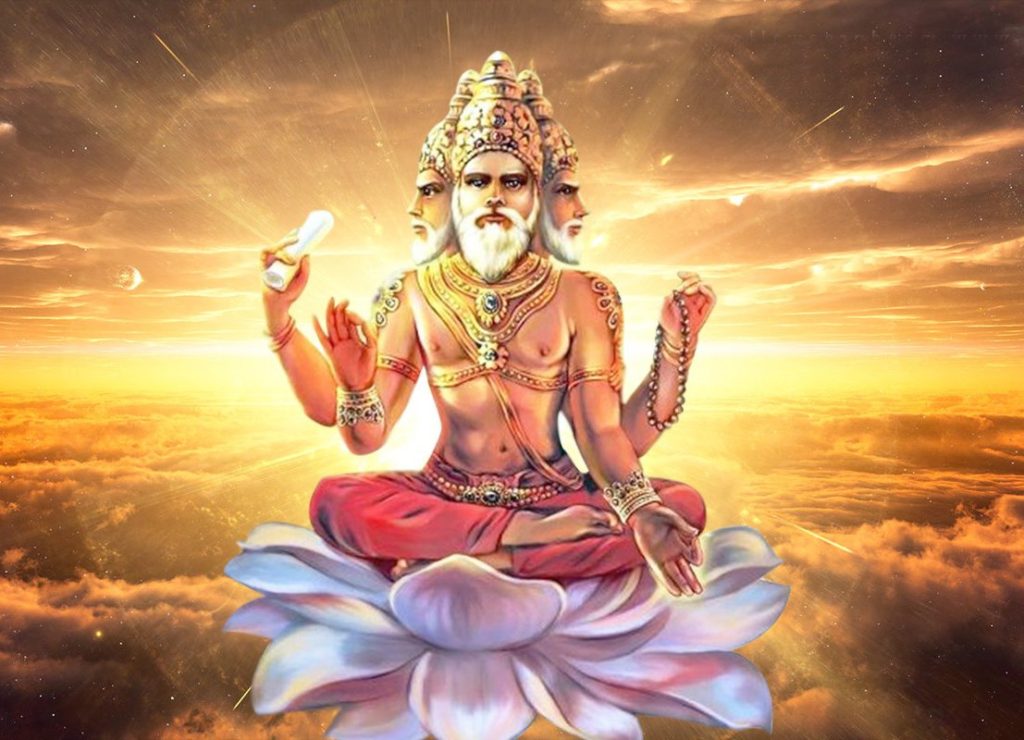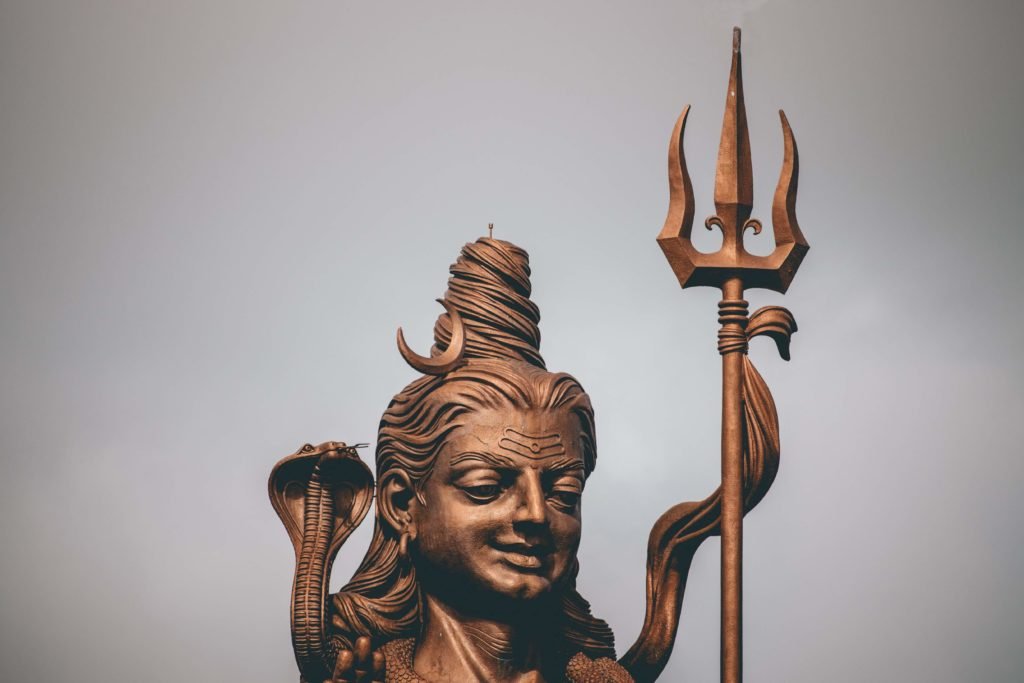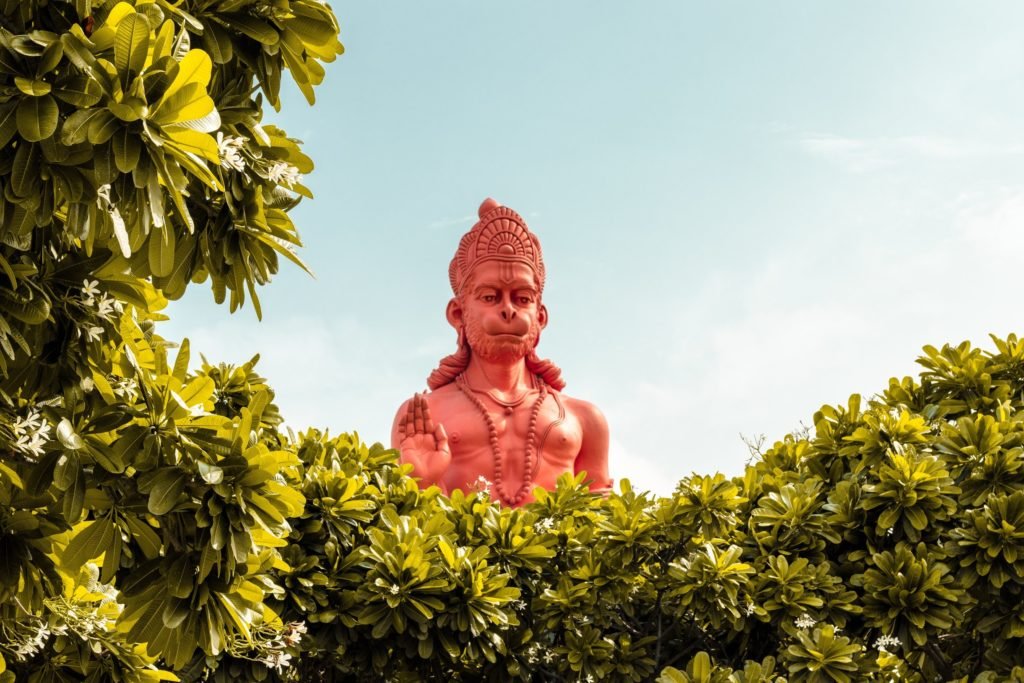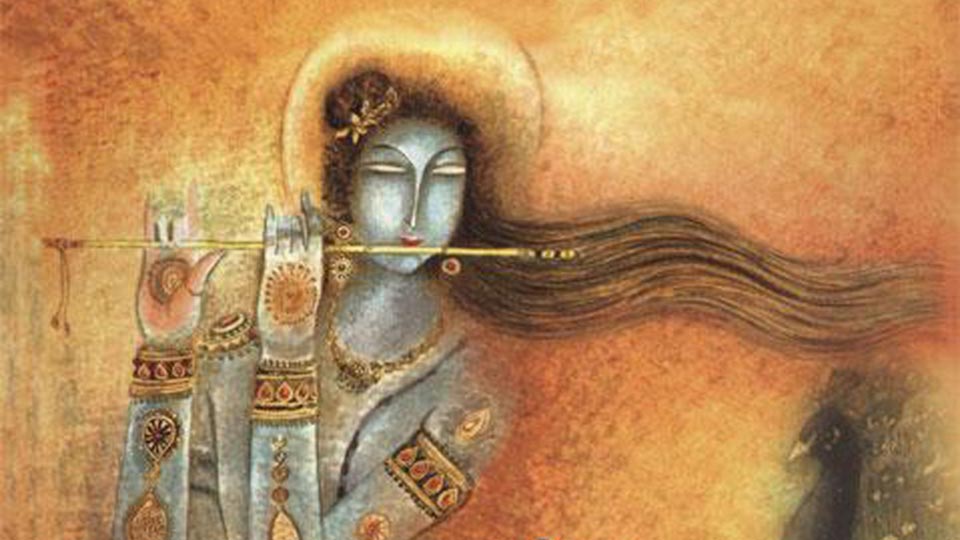Colorful, vibrant, musical, and story-driven, Hinduism is a religion that inspires many across the globe. It is a faith-filled to the brim with gods and goddesses.
In fact, there are over 33 million Hindu gods in total!
There are some you may have heard of: Shiva, Vishnu, Ganesh, or Brahma, to name a few.
Maybe you’ve seen a statue of the elephant-headed Ganesh, the god of beginnings and remover of obstacles.
Or perhaps you’ve seen a portrait of the mighty blue Shiva, the god of destruction, slaying a demon.
Maybe you’ve never seen any of them! Regardless of if you are just learning, taking a spiritual pilgrimage to India, or a yoga teacher training, learning about the Hindu gods is exciting and inspiring.
Besides, spiritual Hindu yoga poses make up the foundation of yoga, making it essential for practitioners to know a bit about the Hindu gods and goddesses that inspire them.
The stories of Hindu gods tell the tales of good versus evil, light versus dark, power, balance, and virtue. Knowing and understanding these stories will not only inspire you to be a better yogi, but they’ll also help you develop into a better person. If a spiritual journey to self-discovery and self-improvement is something you need, then go ahead and book your private yoga retreat today.
Hinduism in India
Yoga and Hinduism are often practices that go hand-in-hand in the West but are more deeply fused and widely practiced in India. Appropriately so, because India is their birthplace. 80% of the population of India identifies with the belief system and recognizes these major Hindu gods.
Stories of these gods are the foundation of Hinduism. They teach about the values and aims of human life and the path to enlightenment.
Hindu mythology has long been a way to pass down these teachings. Hindus worship the gods and goddesses through devotional prayer and meditation. Many perform this kind of “puja’ (worship) in a shrine.
Shrines are a special place you create for prayer and meditation. For instance, they can be anything from altars, rooms, and even pictures and sculptures.
Worshippers decorate these shrines with offerings. These offerings may include mantra or prayer, incense, and flowers. They can be any kind of precious item- provided the person gives it with love and devotion.
Throughout India, you can see incredibly decorated shrines dedicated to different gods. Statues, images, and buildings are colorfully decorated and often fragrant with flowers, especially during important holidays.
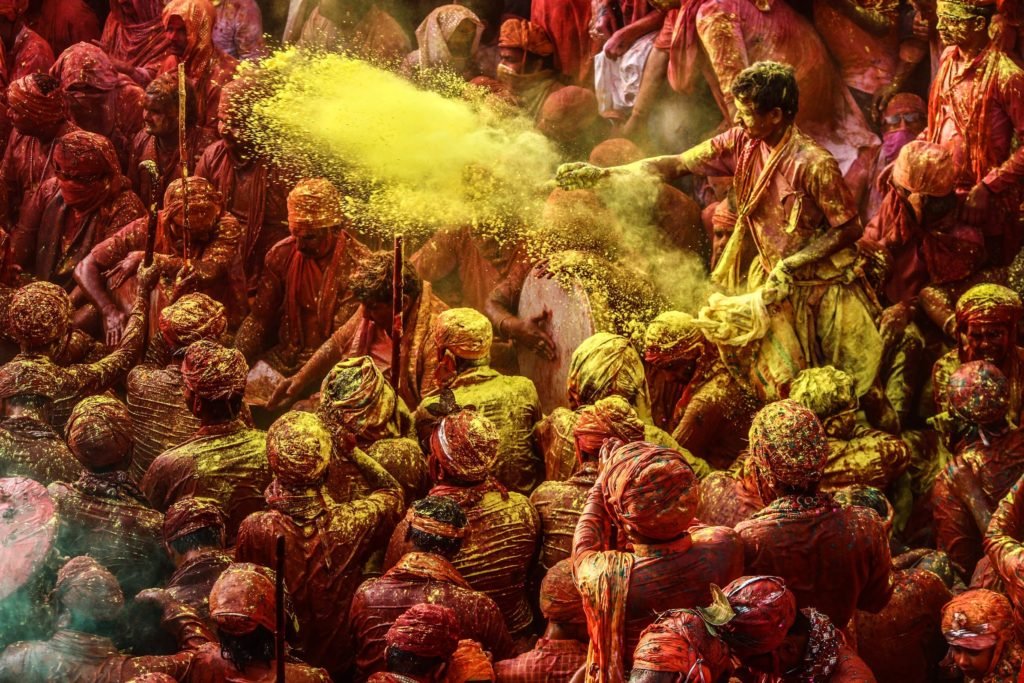
Practice for the non-Hindu
You don’t have to subscribe to these religious beliefs to benefit from the beauty of the practice.
For example, you can create a quiet, spiritual space with your favorite items. In other words, any objects that help you to focus your mind and bring you joy.
If you want to tap into these powerful gods and goddesses, you can cultivate a meditation practice with one in mind. You could even have a statue or image of your favorite god or goddess somewhere in your space of practice.
This can help you focus your attention on whatever qualities your chosen figure represents: wisdom, knowledge, peace, or power, for example.
People have many different kinds of objects on their altars that aren’t religious symbols too. For instance, you can use objects like pictures of teachers or a matriarchal grandmother, a rock or seashell from a meaningful place, or a flower that recalls a special memory.
If it serves you, you can combine all of these things into one. The point is to make your space of worship unique to your practice.
Yoga and your Hindu Gods inspired practice
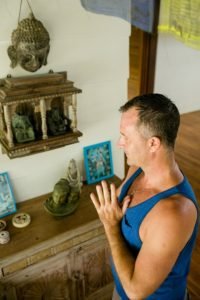 If you are inspired by these Hindu deities, you can find their energies through yoga. Trying specific postures can awaken those dormant energies that are already within you.
If you are inspired by these Hindu deities, you can find their energies through yoga. Trying specific postures can awaken those dormant energies that are already within you.
There are plenty of poses linked to the broad range of powers that each deity holds. Some of these postures focus on building strength. Other yoga poses center around building mental clarity.
Each of these postures can help you bring the strength from the gods of Hinduism into your daily spiritual practice.
IF YOU’RE LOOKING TO PUT YOUR DEVOTION INTO MOTION, HERE ARE 10 HINDU DEITIES AND YOGA POSES YOU SHOULD KNOW
If you’re a devoted yogi and want to take your devotion to the next level, gaining some understanding of the Hindu gods that inspire the yogic lifestyle. Let’s take a brief look at 10 of the most popular Hindu gods and goddesses.
BRAHMA
The first deity of the Hindu trinity, Lord Brahma, is the god of creation. The trinity of Hindu gods being made up of Brahma, Vishnu, and Shiva. Brahma contains the entire cosmos and all its creatures.
Hinduism says that time is cyclical. This is because all creation in the Universe exists for some time and then dies. In short, Brahma reminds us of the cycle of birth and death.
The cycle of creation and death is constant and ceaseless. We are born from Brahma and then return to Brahma.
One of the prayers to say before your meal is:
“This food came from Brahma.
I am about to eat Brahma.
I will return to Brahma.’
Indeed, these prayers help to remind us of the impermanence of life.
As the god of Creation, Brahma also symbolizes the mind and intellect. This is because he is the source of all knowledge necessary for the Universe.
You’ll find Brahma depicted with four faces. The four faces symbolize the completeness of his knowledge.
Brahma also has four hands that each represent an aspect of the human personality. This is mind, intellect, ego, and consciousness.
Brahma is the god of:
- Creation
- Intellect
- Mind
YOGA POSTURE: BRAHMA MUDRA
Although Brahma Mudra is a sitting posture that’s practiced before pranayama. So it also helps improve focus and releases negative energies.
In yoga, Mudras (hand and body gestures) affect the flow of life force energy (prana) throughout the body. They help calm the mind and energize the body.
 Brahma is the name of the Hindu creator god. The translation in Sanskrit is “divine,” “sacred,” or “Supreme Spirit.”
Brahma is the name of the Hindu creator god. The translation in Sanskrit is “divine,” “sacred,” or “Supreme Spirit.”
To evoke the powers of Brahma, Mudra follow this practice.
Place both hands into fists with the fingers wrapped around the thumbs. The palms are facing skyward, and both hands pressed together at the knuckles. The hands then rest against the pubic bone.
The Brahma Mudra is a spiritual hindu yoga pose highly valued for its symbolic and healing properties. It’s also a powerful posture for deep meditation.
VISHNU
The second deity of the Hindu trinity, Vishnu is the Preserver (of life). He sustains life through his adherence to principle, order, righteousness, and truth.
Vishnu’s responsibility is order and balance. He encourages his devotees to show kindness and compassion to all creatures.
Vishnu is depicted with four arms, which represent his omnipotence and omnipresence.
This Hindu deity is a more esoteric god in comparison to those who rule over the natural world since. He is responsible for the divine essence that pervades the Universe.
It is common to see Vishnu seated upon a coiled snake. This symbolizes the ability to remain at peace in the face of fear or worry.
Vishnu is the god of:
- Support
- Order
- Balance
So which of the spiritual Hindu yoga poses is inspired by Vishnu?
YOGA POSTURE: VRIKSHASANA
Vrikshasana (tree pose) requires a sharp mental focus. This focus directs and concentrates the mind. And who doesn’t want a mind that has the power of concentration?
Balancing on one foot requires keeping your eyes on one specific spot.
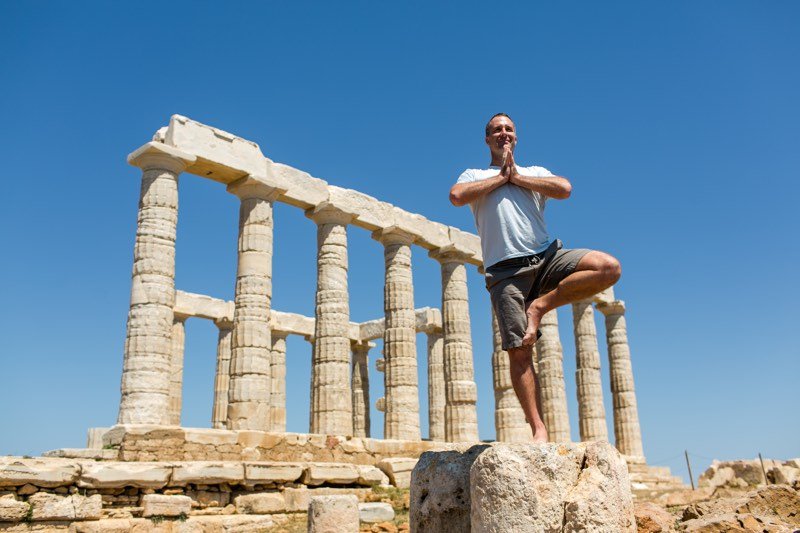
Balancing yoga postures help you direct your energy inward. Keep your eyes focused on a focal point – your Drishti. Your Drishti enables you to focus on staying even keel.
Vishnu can maintain peacefulness and steadfastness in the face of fear.
When practicing Vrikshasana, you build self-trust by overcoming the fear of falling.
Rather than focusing on tipping over, this posture requires you to only focus on maintaining balance.
SHIVA
The final deity of the Hindu trinity is Shiva, also known as The Destroyer – the destroyer of all our “bad” habits. As you travel throughout India, you will see many lingams that represent Shiva.
Shiva protects his followers from destructive vices such as greed, lust, and anger. He also guards them against illusion and ignorance. These are the forces that stand in the way of divine enlightenment, and therefore, prevent us from living a truly meaningful life.
He is also considered to be responsible for the death, destroying to bring rebirth and new life.
Hindus often call upon Shiva before a ritual with this mantra.
‘Om Namah Shivaya’
So this invocation destroys bad energy in physical and energetic space.
Shiva is often depicted with a serpent around his neck, which represents Kundalini, or life energy.
Shiva is the god of:
- Destruction
- Renewal
- Death
YOGA POSTURE: NATARAJASANA
Natarajasana is one of the spiritual Hindu yoga poses inspired by Shiva. The pose represents the deity in one of his most beloved forms. The word Natarajasana comes from two words: nata, meaning acrobat, and raja, meaning king. Shiva, depicted as Nataraj, is often shown dancing to represent this meaning.
Shiva, depicted as Nataraj, is often shown dancing to represent this meaning.
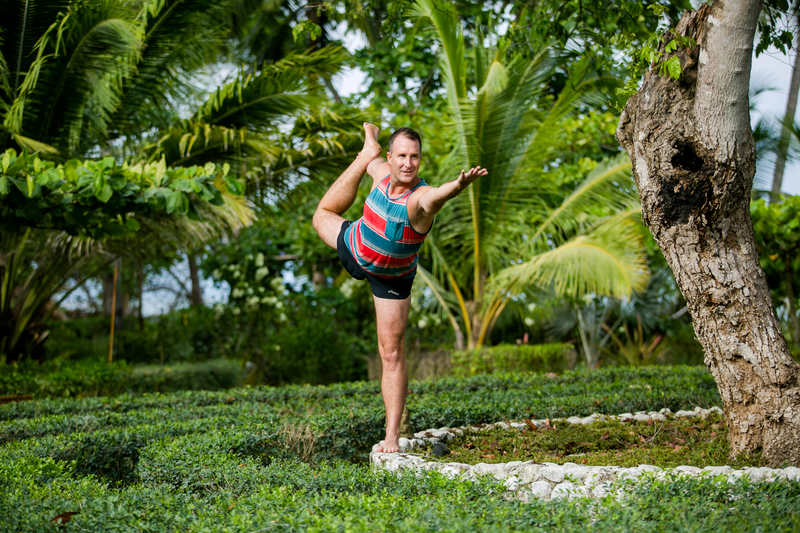
This dance is ever fluctuating and changing. This expression symbolizes the dynamic cultural expression of life. As in life, the external posture may be full of movement and much wobbling when we practice, it requires a still, calm mind to stay balanced.
Evoke the cyclical nature of Shiva by adding Natarajasana into your practice.
[et_bloom_inline optin_id=”optin_16″]
GANESH (OR GANESHA)
Recognized for his elephant head, Ganesh of the most prevalent and best-known deities. (Also known as Ganesha.)
Ganesh is Shiva’s firstborn son. His large, elephantine head symbolizes the wisdom and knowledge that he bestows upon his seekers.
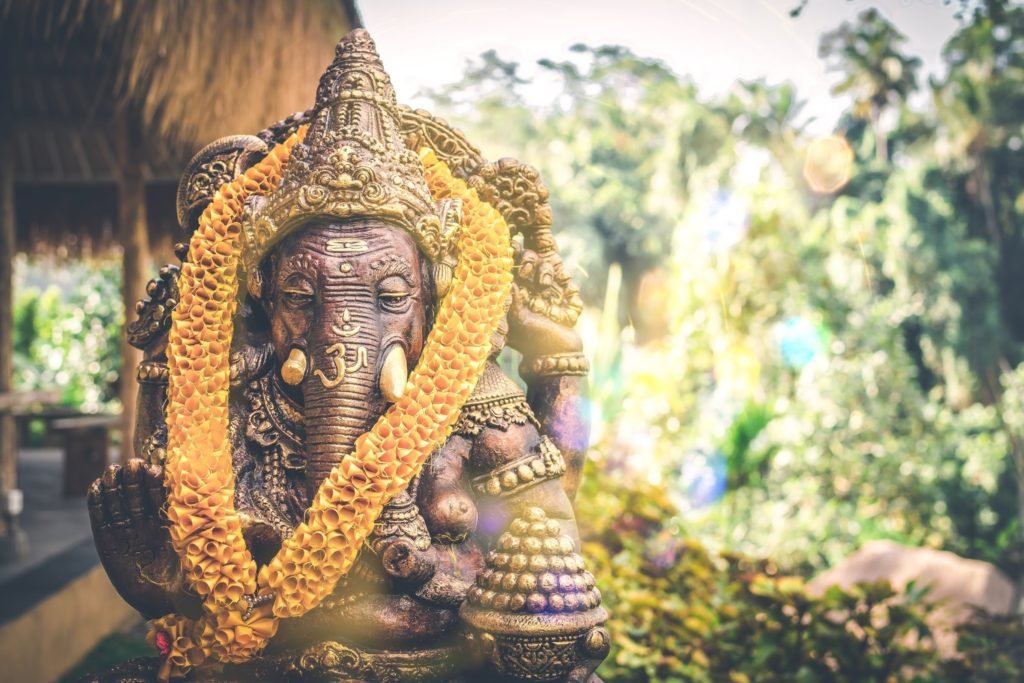
He grants good fortune to those who offer him delicious sweets.
He is the ruler of astrology, mantra (sound), and yoga and is associated with the arts and sciences.
It is especially common to pray to Ganesha before any significant venture such as a wedding or a new project because he removes obstacles to success and good fortune.
Some myths and stories explain how Ganesha came to have an elephant head. Still, it is thought that the humorous image stills the rational mind and its doubts. Therefore, in meditation, we practice looking beyond outer appearances and forms.
Ganesh is the god of:
- Removing obstacles
- Wisdom
- Good Fortune
Which spiritual Hindu yoga poses do we get from Ganesh?
YOGA POSTURE: VIRABHADRASANA II
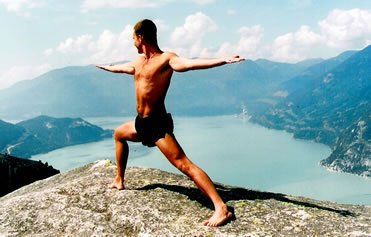 There are a few yoga poses that embody Ganesha’s resilient strength and fearlessness. One of these postures is Virabhadrasana or Warrior II.
There are a few yoga poses that embody Ganesha’s resilient strength and fearlessness. One of these postures is Virabhadrasana or Warrior II.
A yoga posture such as Warrior II emphasizes a connection to the root chakra.
The expansive, stable qualities of Warrior 2 make it the perfect posture to represent Ganesha’s immense strength.
Before embarking on your day or an adventure, you may want to practice this pose inspired by one of the most well-known Hindu gods. It will give you the strength, resilience, wisdom, and good fortune you need to succeed in all your endeavors.
HANUMAN
Another easily distinguishable Hindu god is Hanuman, the deity depicted as a monkey.
Hanuman represents the ideal devotee of the gods. Meditate on Hanuman as a symbol of strength, perseverance, and devotion.
To embody Hanuman is to embody absolute love and dedication.
Yoga is often considered the practice of being able to control one’s mind. Since the five senses are the gateway to the mind, Hanuman is the god of sensory control.
His attributes are often associated with extraordinary strength, as long as he believes in the cause!
Hanuman is often called upon in times of trouble. He teaches us about the unlimited power that lies within the human heart.
When we direct our energies to god, as shown in the epic tale Ramayana, anything is possible.
Hanuman is the god of:
- Perseverance
- Dedication
- Commitment
YOGA POSTURE; HANUMANASANA
Known as ‘the splits,’ Hanumanasana is one posture that needs a lot of dedication and the patience of a saint to master.
The monkey god Hanuman represents devotion, selfless service, dedication, and indomitable willpower.
The physical posture, Hanumanasana, represents his ability to leap great distances. During the battle between Rama and Ravana in the Ramayana, Hanuman jumped from India to Lanka to comfort Sita.
In the story, he brought Sita a ring from Rama to remind her of the love they had for her.
Hanuman was so loyal towards Rama, that when offered a reward for his bravery and dedication to Rama and Sita. He asked only to be able to continue to serve them.
As you practice Hanumanasana, visualize yourself, closing the distance between yourself and your goals.
KRISHNA
Lord Krishna is one of the most powerful incarnations.
As an avatar of Vishnu, Hindus keep Krishna very near to their hearts. Krishna is not only viewed as a hero and leader, but also as a teacher and a friend. He is one of the Hindu gods easiest to relate to thanks to his human attributes.
Krishna is the embodiment of love and divine joy and destroyer of all pain and sins. He embodies joy and celebration despite having had many challenges in his life.
Krishna is a beloved leader because he sees the good in all and loves everyone.
If you have read the Bhagavad Gita, then you are likely already familiar with Krishna. In the Gita, he is the main hero in the epic and has a lot to say about yoga, using the term over 100 times!
Krishna is the god of:
- Joy
- Leadership
- Love
YOGA POSTURE: NATVARASANA
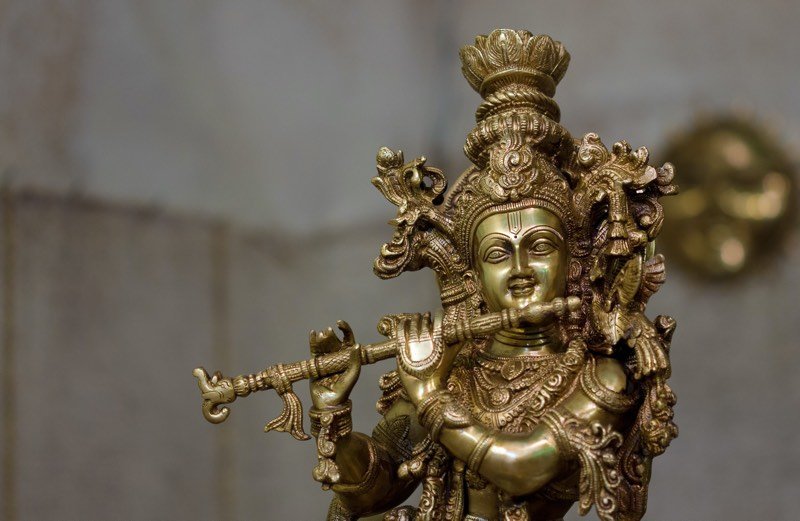 Evoke Lord Krishna’s qualities of concentration and balance by practicing Natvarasana. Krishna is often pictured playing the flute. This asana or yoga posture, Natvarasana, echoes this typical depiction.
Evoke Lord Krishna’s qualities of concentration and balance by practicing Natvarasana. Krishna is often pictured playing the flute. This asana or yoga posture, Natvarasana, echoes this typical depiction.
This posture is practiced before meditation. It helps draw focus inward and improves the stability of the mind.
Krishna’s exceptional leadership qualities required him to be one-track minded and steady.
When practicing Natvarasana, place both feet on the mat, side by side. Gaze at a point on the floor in front of you, steadying your focus.
Bring the right leg forward and move it to the left in front of the left leg. Take it further and tuck the right foot behind the left calf muscle. Place the right foot straight and almost vertical behind the left leg.
Tuck the right toes inside and behind the calf to maintain the balance. Keep the right calf muscles touching on the left leg shin for support.
Raise both hands to the right, bend the elbows and place the palms as if you are playing the flute.
The Natvarasana is one of the spiritual Hindu yoga poses that promote balance and focus in life.
KALI (OR KALI MA)

Kali Ma is the wife of the great god Shiva. Her intense shakti or feminine energy transcends the Western view of good versus evil.
We always see Kali with her tongue protruding from her mouth, her garland of skulls, and her skirt of bones. This is to symbolize the death of the ego.
Kali reminds her devotees that the human body is only a temporary condition.
Contrary to what her image might suggest, she is not responsible for human mortality.
Kali is the goddess of:
- Time
- Change
- Destruction
YOGA POSTURE: UTKATA KONASANA
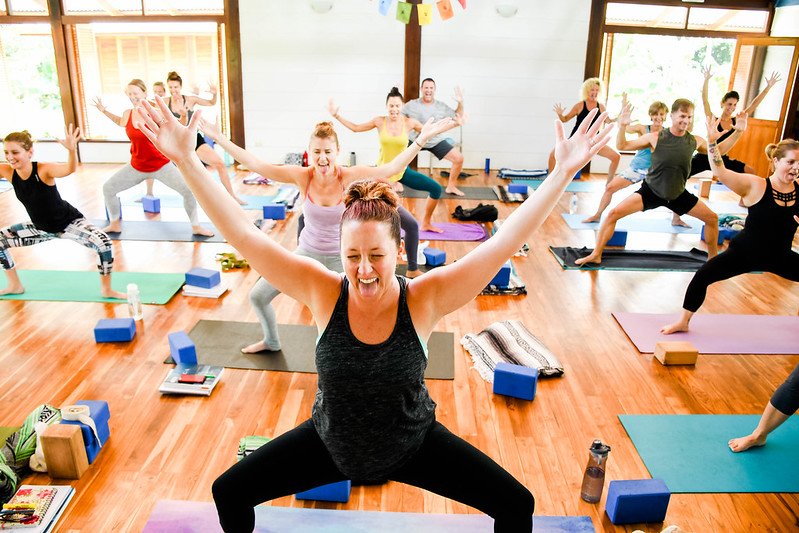
Also known as Goddess Pose, Utkata Konasana brings about the fierce qualities of the Hindu Goddess, Kali.
Stand with legs wide apart. Sink down into a deep squat with toes pointed in opposite directions. Raise your arms above the head. For a more significant effect, stick your tongue out of your mouth as far as you can.
You’ll immediately feel the power this posture brings.
Kali is often depicted in a similar wide stance.
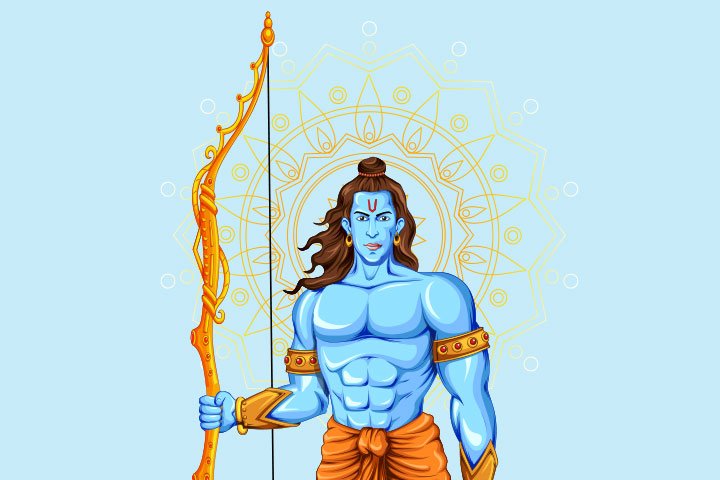
RAMA
Rama is the model of reason and virtue and is often considered to be the ideal man due to his compassion, courage, devotion, and adherence to dharma.
His bow and arrow symbolize his readiness to destroy evil and protect righteousness. Rama is also known for his role as the protagonist in the Ramayana.
Rama is the god of:
- Chivalry
- Virtue
- Fortitude
YOGA POSTURE: MAKARASANA
According to the Indian epic Ramayana, Lord Rama’s wife, Ravana abducted Queen Sita.
Hanuman, the monkey-god, went on a rescue mission to save Queen Sita. During the journey, Hanuman got thirsty and leaned over a river to take a sip. A crocodile grabbed Hanuman by the foot and ate him. And then Hanuman changed his size, killing the croc.
In Indian tradition, the Makara is a fabulous beast. Makara is part crocodile, elephant, sometimes part stag or peacock. It is the vehicle of the river goddess Ganga.
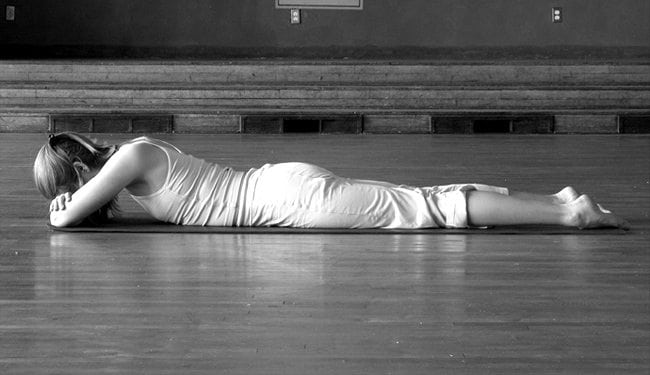
Practice Makrasana or crocodile pose lying facedown on the floor. The abdomen and diaphragm pressing on the floor.
Crocodile pose relaxes the nervous system. It helps draw focus inward and is often practiced at the beginning of a yoga sequence.
SARASWATI
Out of all of the Hindu deities and goddesses, Saraswati is the most beautiful one.
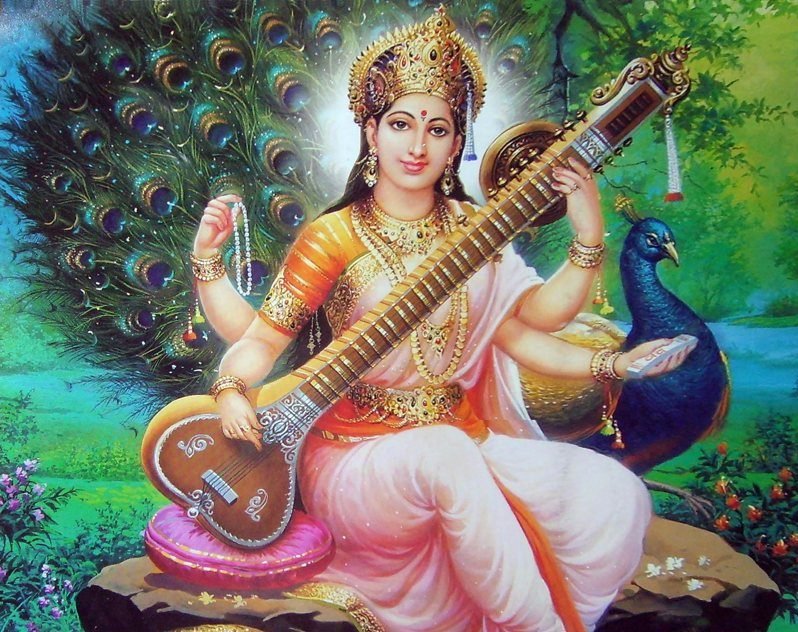
Saraswati is the goddess of learning, music, art, and wisdom. People meditate on her when they desire knowledge or understanding.
Most often, many representations depict Saraswati as a beautiful woman. She is usually playing the flute, seated upon a white lotus or a swan.
Saraswati wears no jewelry or makeup. Although she rejects the material world, she is indeed a striking woman.
Saraswati is the goddess of:
- Knowledge
- Music
- Art
YOGA POSTURE: BITILASANA
 Goddess Saraswati is also known as the “free-flowing one.”
Goddess Saraswati is also known as the “free-flowing one.”
Her feminine, free-flowing qualities echo the cyclical nature of the divine feminine.
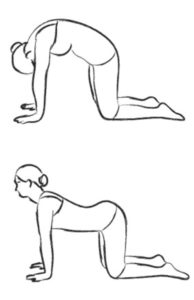 Practice Cow pose or Bitilasana from the table-top position on all fours.
Practice Cow pose or Bitilasana from the table-top position on all fours.
The stretch lengthens the muscles of the abdomen. Move between Cow pose and cat pose.
The oscillation between cat and cow helps awaken both the front and back body. So, this movement prepares us for standing postures.
Saraswati is the free-flowing creative energy that lives within everyone.
DURGA
The goddess Durga is an essential representation of the Divine Mother, also known as ‘the Invincible.’
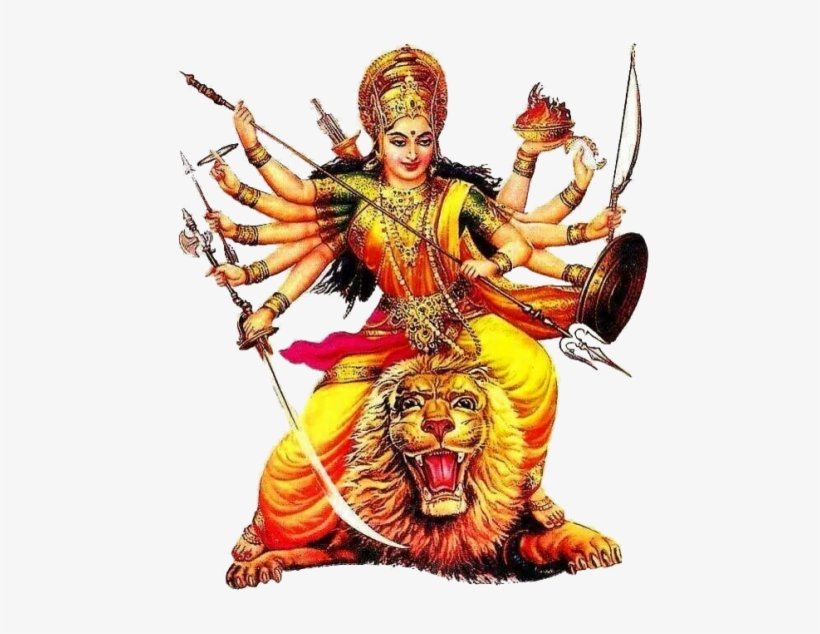
As the destructive force of jealousy, prejudice, hatred, and ego plague mankind. As a result, to invoke Durga is to protect oneself from these forces.
Durga is depicted with eight arms holding a myriad of weapons. Therefore, this shows that she is always protecting mankind in every direction of the world.
A well-known story about Durga depicts her on the battlefield. After slaying all her enemies, she hears a baby crying. So, she walks over, brings the baby to her breast, and begins to feed it.
This story demonstrates the power of strength, coupled with compassion.
Durga is the goddess of:
- Leadership
- Warrior
- Strength
YOGA POSTURE: AGNI SARA
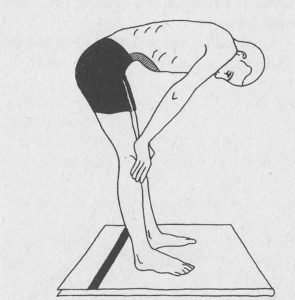 If you need to slay the dragons of negativity, invoke Durga to help you embody the inner strength and power to transform.
If you need to slay the dragons of negativity, invoke Durga to help you embody the inner strength and power to transform.
Agni or fire is a crucial element to transform energy and matter. This spiritual fire is a powerful force in the mind that dissolves or dissipates anger, fear, and greed. The power of Durga asks us to stoke the fire within ourselves.
The practice of Agni Sara helps stoke your internal fire that is the seed of transformation.
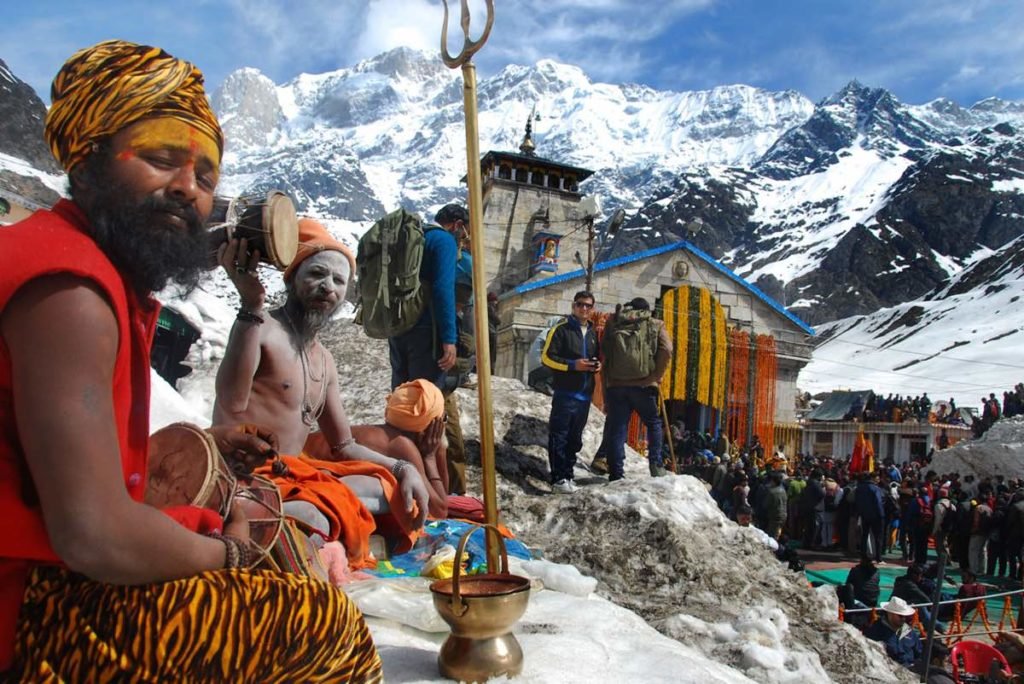
There are plenty of ways to bring the strength and wisdom of Hindu gods and goddesses into your life and practice.
These deities can help inspire your practice and call on the mighty forces of the millions of Hindu gods and goddesses.
Building your practice around the infinite qualities of creation begins with knowing the powers of each god and goddess.
But if you are lucky enough to take a pilgrimage to India, keep your eyes and hearts open. Maybe, you will likely encounter the energy of many of these deities on your journey!


